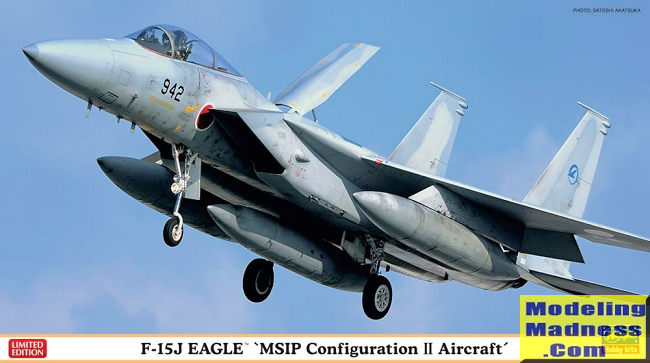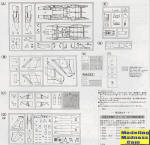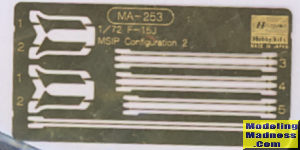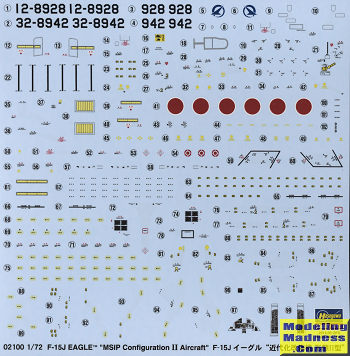
| KIT #: | 2100 |
| PRICE: | @ $30.00 shipped |
| DECALS: | Two options |
| REVIEWER: | Scott Van Aken |
| NOTES: | 2014 limited edition boxing. |

| HISTORY |
F-15Js have been equipped with the Japanese-built AAM-3 missile, an improved AIM-9 Sidewinder follow-on with distinctive "barbed" forward fins. Japan has been investigating an advanced fighter to replace the F-15, meanwhile the F-15J fleet is being modernised. On 28 July 2003, the first upgraded F-15J (#928) made its first flight, and it was delivered to the JASDF Air Development Test Wing on 21 October 2003.
On 10 December 2004, the Japanese Government approved a Mid-Term Defense Program (MTDP) to modernize the F-15J MSIPs over five years in accordance with new National Defense Program Guidelines. The upgrade is being implemented in phases, but ultimately the upgrade will include a new ejection seat; replaced IHI-220E engines; more powerful processor; uprated electrical generation and cooling capabilities to support more avionics and the Raytheon AN/APG-63(V)1 radar which has been produced under license by Mitsubishi Electric since 1997. Raytheon expects the radar will ultimately be installed in 80 F-15Js. The new radar will support the AAM-4 missile, the Japanese answer to the AMRAAM.
The Ministry of Defense (MoD) requested the modernization and deployment of reconnaissance aircraft in June 2007, and it was planned to upgrade some F-15Js with synthetic aperture radar pods; these aircraft would replace the RF-4 Phantom IIs currently in service.
On 17 December 2009, the reconnaissance upgrade disappeared from the budget after the Democratic Party took power following the General Election in 2009, and priority was given instead to improvement of the F-15J and the Mitsubishi F-2. The number of F-15J upgrades was increased from 26 to 48, and the MoD purchased the part of the modernization for 38 fighters, however, the full budget for modernization is incomplete. 48 F-15Js will get a Link 16 datalink and helmet-mounted sight. The helmet-mounted sight will support the AAM-5 dogfighting missile, which will replace the AAM-3.
On 17 December 2010, modernization was funded for 16 F-15Js but the MoD reduced this to 10 F-15Js.
| THE KIT |
 Hasegawa's superb 1/72 F-15 Eagle has been around for
quite a long time and is still considered by many to be one of the best around.
They have competition, however, from Academy and recently from Platz among
others so there are a lot of choices. Still, a lot of people like the Hasegawa
kit and I'm one of them.
Hasegawa's superb 1/72 F-15 Eagle has been around for
quite a long time and is still considered by many to be one of the best around.
They have competition, however, from Academy and recently from Platz among
others so there are a lot of choices. Still, a lot of people like the Hasegawa
kit and I'm one of them.
There are only so many ways to engineer an F-15 kit. This one is typical with a separate forward fuselage split vertically and the aft fuselage split horizontally. The cockpit is nicely done with raised detail on the consoles and instrument panel as well as providing decals if you so wish.
 For this boxing, there is an additional T sprue and
some photo etch. The p.e. is for radome reinforcement strips and fin
reinforcement plates. Items on the additional sprue are a new instrument panel
anti-glare section, IR seeker, as well as additional antennas for the sides of
the intake. Note also that one of the markings options has antennas on the rear
of the fuselage outside of the exhaust while the other does not. In other words,
you need to know which of the two markings options you want to use prior to
starting the build.
For this boxing, there is an additional T sprue and
some photo etch. The p.e. is for radome reinforcement strips and fin
reinforcement plates. Items on the additional sprue are a new instrument panel
anti-glare section, IR seeker, as well as additional antennas for the sides of
the intake. Note also that one of the markings options has antennas on the rear
of the fuselage outside of the exhaust while the other does not. In other words,
you need to know which of the two markings options you want to use prior to
starting the build.
Hasegawa already opens the holes in the lower wings
and the lower fuselage for the pylons that go there. You are provided with
missile rails if you want to use them and you get fuel tanks for all the pylons.
Exhaust are the later versions without the 'turkey feathers' so you will need to
install the afterburner actuator rods, but this is a pretty easy task. Both the
canopy and speed brake can be posed open or
 closed. Landing gear is nicely done
as are the wheels. Note that only the small gear doors remain open on the ground
unless undergoing some sort of maintenance. To fit all the gear struts you do
have to wait until after the gear legs are installed before attaching these and
the nose door.
closed. Landing gear is nicely done
as are the wheels. Note that only the small gear doors remain open on the ground
unless undergoing some sort of maintenance. To fit all the gear struts you do
have to wait until after the gear legs are installed before attaching these and
the nose door.
You are provided with two markings options, both of them with the ADTW, the test wing of the JASDF. One plane was used to test the IR antenna system and the other was used for the ESM antennas. Other than the serial and nose number, both are identical. Japan never used the Mod Eagle scheme so these planes are in the older ghost grey scheme. Decals are very nicely done and typical of F-15s, has a ton of stencils. Some of these are in 'groups' so that will lessen the time it takes to apply them all.
| CONCLUSIONS |
I bought this kit to use with the recent Caracal Decals sheet on Lakenheath F-15Cs as it was recommended. However, from what I gather, US MSIP II upgrades contain no external clues aside from perhaps a GPS antenna. If you know more about it, let me know. Anyway, this is a nicely done kit and anyone with some building experience should be able to make a very nice model with it.
| REFERENCES |
https://en.wikipedia.org/wiki/Mitsubishi_F-15J
April 2018 Copyright
ModelingMadness.com. All rights reserved. If you would like your product reviewed fairly and fairly quickly, please
contact
the editor or see other details in the
Note to
Contributors.
Back to the Main Page
Back to the Review
Index Page
Back to the Previews Index Page